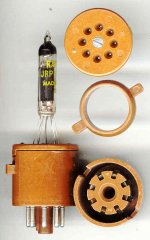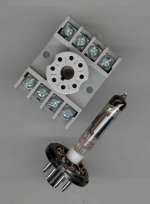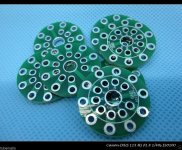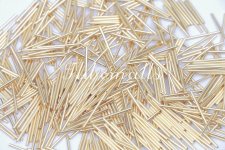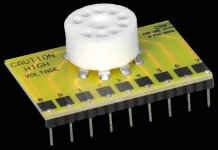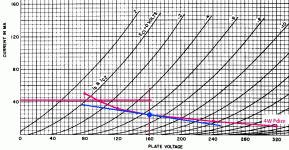Guys,
Tubes we regard as completely satisfactory for audio are also video O/P tubes. Consider the 6BQ5/EL84, 6CH6/EL821, and the 6П15П/SV83. Please notice the 150 V. g2 limit for the 6П15П. It makes a fine triode, but to protect the fragile screen grid a 1 KOhm resistor, instead of the more common 100 Ω part, is used as the strapping element.
Tubes we regard as completely satisfactory for audio are also video O/P tubes. Consider the 6BQ5/EL84, 6CH6/EL821, and the 6П15П/SV83. Please notice the 150 V. g2 limit for the 6П15П. It makes a fine triode, but to protect the fragile screen grid a 1 KOhm resistor, instead of the more common 100 Ω part, is used as the strapping element.
Please notice the 150 V. g2 limit for the 6П15П. It makes a fine triode, but to protect the fragile screen grid a 1 KOhm resistor, instead of the more common 100 Ω part, is used as the strapping element.
Actually, what should be limited, is power dissipated by the screen grid which has to be less than 1.5 Watt. In triode mode it is absolutely out of concern since screen grid voltage can not be higher than anode voltage, so no resistors are needed.
The tube is very linear in triode mode.
Octal predecessor of 6П15П (6P15P) is 6P9 (6П9)
How about subminiature video pentode?
Hi,
While I sit and digest...
(read and read over these threads and textbooks, and try to understand the experts)...
What about video pentode, like the submini 5639?
On a whim I bought some for cheap and no loss to me if they're not the best selection of tube for modest audio outputs (I have some 6Pi30BR also)
(Datasheet attached)
Can someone help me understand what peculiarities to expect with an internally connected Cathode and G3?
The datasheet has triode curves, or that's how I interpret them, G2 and anode current as a f(G1), but a reasonable anode current appears miles away from a reasonable G1 bias level.
Resurrecting another aged thread...I'll be damned!
Hi,
While I sit and digest...
(read and read over these threads and textbooks, and try to understand the experts)...
What about video pentode, like the submini 5639?
On a whim I bought some for cheap and no loss to me if they're not the best selection of tube for modest audio outputs (I have some 6Pi30BR also)
(Datasheet attached)
Can someone help me understand what peculiarities to expect with an internally connected Cathode and G3?
The datasheet has triode curves, or that's how I interpret them, G2 and anode current as a f(G1), but a reasonable anode current appears miles away from a reasonable G1 bias level.
Resurrecting another aged thread...I'll be damned!
Attachments
I have some 5639 tubes here, PhilipsECG and some no name ones with an A6J code. Both very similar construction. Looking inside I see these are not frame grid, and have non aligned grids 1 and 2. Grid 3 is a beam forming plate. Seeing as the Sylvania data sheet curves have square knees, they seem to be optimal already. (no need to put some V on grid3) Although the Raytheon data sheet shows more curvature in the plate curves, more like a 6BQ5. Pentode Rp high-ish at 50K Ohm.
Checking the JEDEC registration, I see Sylvania registered the 5639 in 4/12 1950.
The max DC current rating (design maximum) is 40 mA, so best to keep the avg. below that some. I'm surprised to see positive grid1 curves, but I guess those are for pulsed operation (video blanking). I wouldn't use positive grid 1 for audio with these anyway. The triode curves have some roll-over to them, so 2nd harmonic presence. Triode Mu around 15 to 12.5 approx. Triode Rp around 1667 Ohms at 21 mA. Should be good for P-P, a few Watts into a hi Z OT maybe. Would also make good driver tubes for 5902 sub-mini output tubes. (use some local N Fdbks to the drivers to lower the output Z then)
I bought an Edcor GXPP10-8-12K OT to try these out, have some 5902 tubes too, but I haven't done that yet. Other than the Sylvania sharp knees, these 5639s seem like sub-mini versions of 6BQ5/EL84 tubes. I would use a stopper resistor on grid 1, should be tame-able tubes.
Checking the JEDEC registration, I see Sylvania registered the 5639 in 4/12 1950.
The max DC current rating (design maximum) is 40 mA, so best to keep the avg. below that some. I'm surprised to see positive grid1 curves, but I guess those are for pulsed operation (video blanking). I wouldn't use positive grid 1 for audio with these anyway. The triode curves have some roll-over to them, so 2nd harmonic presence. Triode Mu around 15 to 12.5 approx. Triode Rp around 1667 Ohms at 21 mA. Should be good for P-P, a few Watts into a hi Z OT maybe. Would also make good driver tubes for 5902 sub-mini output tubes. (use some local N Fdbks to the drivers to lower the output Z then)
I bought an Edcor GXPP10-8-12K OT to try these out, have some 5902 tubes too, but I haven't done that yet. Other than the Sylvania sharp knees, these 5639s seem like sub-mini versions of 6BQ5/EL84 tubes. I would use a stopper resistor on grid 1, should be tame-able tubes.
Last edited:
Looking a little closer at the 5639 insides, I see that the grid3 is just two wires down the sides of the beams on each side, with small sheet metal joinings at the ends.
I found a tube with a B6J code also, mostly A6J marked ones.
I'll bet these are all Sylvania/PhilipsECG tubes. Only the getter construction is different on the Philips. Very nice pentode curves on the curve tracer. Nice low knee voltages, should work good for LV amps. I'd say these are keepers, just need to find the right niches to use them in.
Might be interesting to use them as drivers for 12HL7, or the like, video amp type outputs. Gate stoppers well supplied all around for sure! (might reach critical density with hi gm video tubes everywhere) With N Fdbks to the 5639 drivers to lower the output impedance. I think an 8K P-P OT would fit for the P-P 12HL7s, unless paralleled up for more power.
Guess one could call it the VIDEO Amp then.
Sylvania made some ZIF tube socket adapters (to Octal) for these 8 wire sub-mini tubes. (pic below with a Raytheon 5902)
I found a tube with a B6J code also, mostly A6J marked ones.
I'll bet these are all Sylvania/PhilipsECG tubes. Only the getter construction is different on the Philips. Very nice pentode curves on the curve tracer. Nice low knee voltages, should work good for LV amps. I'd say these are keepers, just need to find the right niches to use them in.
Might be interesting to use them as drivers for 12HL7, or the like, video amp type outputs. Gate stoppers well supplied all around for sure! (might reach critical density with hi gm video tubes everywhere) With N Fdbks to the 5639 drivers to lower the output impedance. I think an 8K P-P OT would fit for the P-P 12HL7s, unless paralleled up for more power.
Guess one could call it the VIDEO Amp then.
Sylvania made some ZIF tube socket adapters (to Octal) for these 8 wire sub-mini tubes. (pic below with a Raytheon 5902)
Attachments
Last edited:
Wow thanks for the detailed reply!
I saw plate dissipation and figured maybe an output of a watt, in push pull, then read this thread and wondered if instability wpuld make the task very difficult.
I saw the triode like curves, and I agree that they don't look anything like a linear as for example the traces Wavebourn posted a couple of posts back.
I'd try as a pentode, but I'm only just getting my head around triodes!
I saw plate dissipation and figured maybe an output of a watt, in push pull, then read this thread and wondered if instability wpuld make the task very difficult.
I saw the triode like curves, and I agree that they don't look anything like a linear as for example the traces Wavebourn posted a couple of posts back.
I'd try as a pentode, but I'm only just getting my head around triodes!
The only other code on mine is BWB 1093, I figure these are fairly modern Sylvania.
I can't see inside as clearly as you (eyesight and experience) but black plate/s, and a good, or gold coloured Grid. Which one, is a mystery to me haha. And they have a halo type getter.
I can't see inside as clearly as you (eyesight and experience) but black plate/s, and a good, or gold coloured Grid. Which one, is a mystery to me haha. And they have a halo type getter.
Last edited:
Looks like grid 1 is gold plated. Most tubes are that way.
The other type of socket I have used for these (for curve tracing) are the 8 pin Augat Teflon IC sockets. (pic below on Octal wafer)
And there are some adapter wafers and pins on Ebay that would allow converting the sub-mini tubes to 7 or 9 pin miniature tube sockets. (pics)
There are several 5902 sub-mini tube amps around (low power). Usually using a 6021 triode front end. The lowish Mu used for low N Fdbk designs. 5639 drivers would be massive overkill in pentode, unless one puts in the local N Fdbks or use them as Mu 15 triodes.
The other type of socket I have used for these (for curve tracing) are the 8 pin Augat Teflon IC sockets. (pic below on Octal wafer)
And there are some adapter wafers and pins on Ebay that would allow converting the sub-mini tubes to 7 or 9 pin miniature tube sockets. (pics)
There are several 5902 sub-mini tube amps around (low power). Usually using a 6021 triode front end. The lowish Mu used for low N Fdbk designs. 5639 drivers would be massive overkill in pentode, unless one puts in the local N Fdbks or use them as Mu 15 triodes.
Attachments
Last edited:
I've seen several amps builds around 5902 outputs, but they're costly to buy now, it seems fewer and further between.
For the moment I have 5639 and waiting delivery of some 6n17b and 6p30br, so ill have those tubes to pick between. (Excluding a very used pair of Chinese 6L6) edit, I know 6n16b aren't op tubes...
I have 6N16B (mu 25) of one variant or other, 6111, 6112/6498 (mu 70), and have seen schematics online, knowing whether they're good is another thing.
For a guitar amp I'll probably use something I find online. There's more than a few options here.
For the moment I have 5639 and waiting delivery of some 6n17b and 6p30br, so ill have those tubes to pick between. (Excluding a very used pair of Chinese 6L6) edit, I know 6n16b aren't op tubes...
I have 6N16B (mu 25) of one variant or other, 6111, 6112/6498 (mu 70), and have seen schematics online, knowing whether they're good is another thing.
For a guitar amp I'll probably use something I find online. There's more than a few options here.
I found a bunch of Raytheon 5902 cheap on Ebay about a year ago. They have poor looking knees compared to the datasheet, but can be designed around OK. Might still be cheap, but probably better to get another brand if an option. 5902 gives you 50 mA DC max spec versus the 40 mA DC max spec for 5639.
I also found CK5744 tubes cheap a year ago, a single Mu 70 triode, 1.1 Watt.
6021 tubes used to be cheap years ago, but have gone way up in price.
There are some 5 Watt 9 pin video tubes on the $1 list at ESRC still, like 6LY8, 6KV8, 6KR8, 6LQ8, all high gm frame grid. But apparently only around 25 to 30 mA max DC.
The 10 Watt 9 pin Videos: 12HL7 (and 12HG7, 12GN7, 8AL9, 6AG9, 6AH9 ...) only rate around 50 mA max DC, which I figure is the minimum I would want to see for an output stage to keep the OT primary Z down to reasonable Ohms. (without paralleling)
The 10 Watt 6HB6 (and higher htr V versions, 9 pin) is a high gm tube at 20,000, and looks like it could be rated for 60 mA max DC. So a nice output tube, similar to 6BQ5. If you can find them now. (maybe higher V htr can be found yet) Were even on the $1 list once. But most of them got bought up (like 3,000's) by some Hong Kong buyer.
I also found CK5744 tubes cheap a year ago, a single Mu 70 triode, 1.1 Watt.
6021 tubes used to be cheap years ago, but have gone way up in price.
There are some 5 Watt 9 pin video tubes on the $1 list at ESRC still, like 6LY8, 6KV8, 6KR8, 6LQ8, all high gm frame grid. But apparently only around 25 to 30 mA max DC.
The 10 Watt 9 pin Videos: 12HL7 (and 12HG7, 12GN7, 8AL9, 6AG9, 6AH9 ...) only rate around 50 mA max DC, which I figure is the minimum I would want to see for an output stage to keep the OT primary Z down to reasonable Ohms. (without paralleling)
The 10 Watt 6HB6 (and higher htr V versions, 9 pin) is a high gm tube at 20,000, and looks like it could be rated for 60 mA max DC. So a nice output tube, similar to 6BQ5. If you can find them now. (maybe higher V htr can be found yet) Were even on the $1 list once. But most of them got bought up (like 3,000's) by some Hong Kong buyer.
Last edited:
...I saw plate dissipation and figured maybe an output of a watt, in push pull,...
I get 0.6W triode SE, 160V 25mA 6.4K load. There's no huge peak current available so push-pull may be 1.2W.
OTOH as pentode there's near 1.4W in SE, perhaps a monster 3W in P-P. And if you are thinking guitar amp, pentodes ARE rock-n-roll.
Attachments
PRR,
that's pretty much my thoughts - many guitar amps are pentode push pull as far as I know. The curvy triode curves look interesting for a dirty guitar amp, which may not do clean too well. Once i get my head around a few things, like losing excess gain, it might indeed make quite a cool guitar amp.
Piano3,
I wasn't specifically looking for video tubes, per se, but rather stumbled upon these 5639 video pentodes and thought they could be turned to a different use.
I'm patiently waiting some 6p30b from Ukraine, which look like the best output tubes (compared with 5639) with something like 60mA plate current.
that's pretty much my thoughts - many guitar amps are pentode push pull as far as I know. The curvy triode curves look interesting for a dirty guitar amp, which may not do clean too well. Once i get my head around a few things, like losing excess gain, it might indeed make quite a cool guitar amp.
Piano3,
I wasn't specifically looking for video tubes, per se, but rather stumbled upon these 5639 video pentodes and thought they could be turned to a different use.
I'm patiently waiting some 6p30b from Ukraine, which look like the best output tubes (compared with 5639) with something like 60mA plate current.
I get 0.6W triode SE, 160V 25mA 6.4K load. There's no huge peak current available so push-pull may be 1.2W.
OTOH as pentode there's near 1.4W in SE, perhaps a monster 3W in P-P. And if you are thinking guitar amp, pentodes ARE rock-n-roll.
Interestingly, one of the many datasheets for this tube (Phillips datasheet) includes some characteristics in Class A single ended application as AF amplifier, with output of 1 W used as a pentode. Looks easy enough to try!
Oh and I've cut some DIP sockets into strip of 4 to use as a solderable tube socket of sorts.
I just need to Megger them at 500V and check the IR is good enough...
Pins are so close on these subminiatures that anything close to 500V will arc at the tube if it doesn't the socket.
Pins are so close on these subminiatures that anything close to 500V will arc at the tube if it doesn't the socket.
1) DIP sockets are cheap enough to try IR test at 500V
2) Arcing at 500V from a Megger with ~0.1" air gap? Unlikely, but 'have Nomex, will travel", so I can mitigate anyway.
But
DIP pins may not like the heat.
Have plenty of free pins, heatshrunk tubing. Could do with some ceramic tubes/beads.
Perhaps, I can just drill a piece of scrap Glassfibre with the 8mm PCD, press home the pins.
Or maybe more involved PCB adapters. Probably no need unless trying to stay with a 0.1" matrix.
And just to be clear, I wouldn't be putting 500V on the tube at any point.
Last edited:
What about video pentode, like the submini 5639?
I used a 5639 as the output in a table radio,
An externally hosted image should be here but it was not working when we last tested it.
here is a solid state table radio (a Panasonic AM/FM model RE-6280) that I added a tube audio output to. The tube is a subminiature 5639 "video" output pentode, not a beam power pentode. Normally this tube isn't all that linear in pentode mode, so triode mode improves it. But oddly enough, inserting a 5K screen resistor into the triode wired mode makes it more linear yet. AFAICT, this is just special to this kind of tube. But this might be applicable to other oddball tubes otherwise not usable for audio.
The B+ is just directly rectified off the powerline, making this a hot chassis radio. But this radio chassis is easily isolated for safety.
Of course you'd use an isolated, ie, power transformer based power supply in an audio amp!
- Status
- This old topic is closed. If you want to reopen this topic, contact a moderator using the "Report Post" button.
- Home
- Amplifiers
- Tubes / Valves
- Video pentodes as outputs
